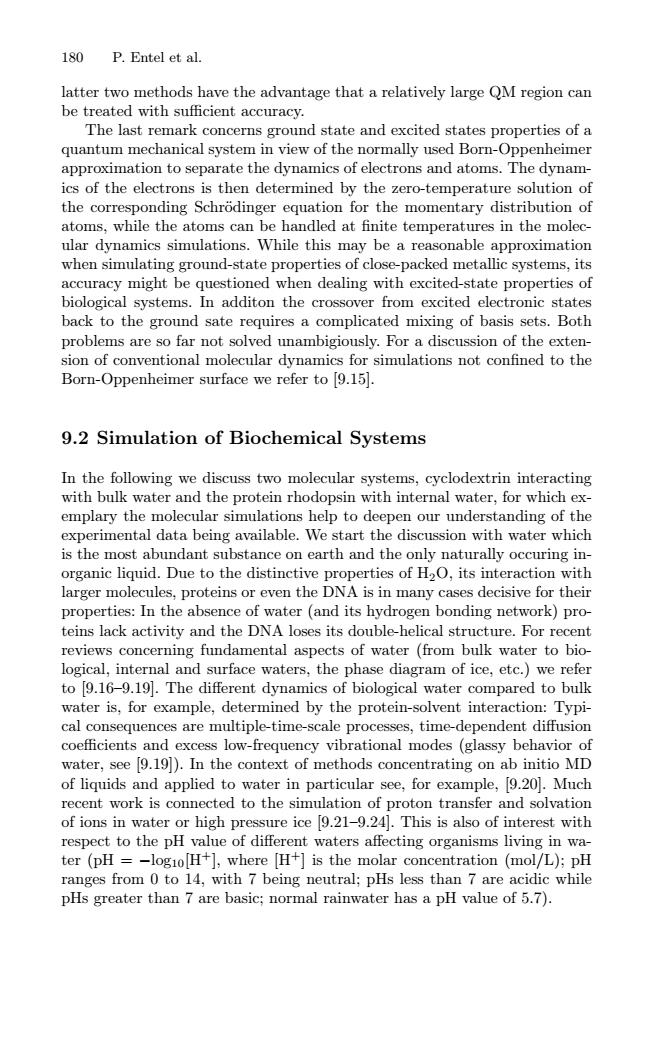正在加载图片...

180 P.Entel et al. latter two methods have the advantage that a relatively large QM region can be treated with sufficient accuracy. The last remark concerns ground state and excited states properties of a quantum mechanical system in view of the normally used Born-Oppenheimer approximation to separate the dynamics of electrons and atoms.The dynam- ics of the electrons is then determined by the zero-temperature solution of the corresponding Schrodinger equation for the momentary distribution of atoms,while the atoms can be handled at finite temperatures in the molec- ular dynamics simulations.While this may be a reasonable approximation when simulating ground-state properties of close-packed metallic systems,its accuracy might be questioned when dealing with excited-state properties of biological systems.In additon the crossover from excited electronic states back to the ground sate requires a complicated mixing of basis sets.Both problems are so far not solved unambigiously.For a discussion of the exten- sion of conventional molecular dynamics for simulations not confined to the Born-Oppenheimer surface we refer to [9.15]. 9.2 Simulation of Biochemical Systems In the following we discuss two molecular systems,cyclodextrin interacting with bulk water and the protein rhodopsin with internal water,for which ex- emplary the molecular simulations help to deepen our understanding of the experimental data being available.We start the discussion with water which is the most abundant substance on earth and the only naturally occuring in- organic liquid.Due to the distinctive properties of H2O,its interaction with larger molecules,proteins or even the DNA is in many cases decisive for their properties:In the absence of water (and its hydrogen bonding network)pro- teins lack activity and the DNA loses its double-helical structure.For recent reviews concerning fundamental aspects of water (from bulk water to bio- logical,internal and surface waters,the phase diagram of ice,etc.)we refer to 9.16-9.19.The different dynamics of biological water compared to bulk water is,for example,determined by the protein-solvent interaction:Typi- cal consequences are multiple-time-scale processes,time-dependent diffusion coefficients and excess low-frequency vibrational modes (glassy behavior of water,see 9.19).In the context of methods concentrating on ab initio MD of liquids and applied to water in particular see,for example,[9.20.Much recent work is connected to the simulation of proton transfer and solvation of ions in water or high pressure ice [9.21-9.24].This is also of interest with respect to the pH value of different waters affecting organisms living in wa- ter (pH =-log10 H+],where H+]is the molar concentration (mol/L);pH ranges from 0 to 14,with 7 being neutral;pHs less than 7 are acidic while pHs greater than 7 are basic;normal rainwater has a pH value of 5.7).180 P. Entel et al. latter two methods have the advantage that a relatively large QM region can be treated with sufficient accuracy. The last remark concerns ground state and excited states properties of a quantum mechanical system in view of the normally used Born-Oppenheimer approximation to separate the dynamics of electrons and atoms. The dynamics of the electrons is then determined by the zero-temperature solution of the corresponding Schr¨odinger equation for the momentary distribution of atoms, while the atoms can be handled at finite temperatures in the molecular dynamics simulations. While this may be a reasonable approximation when simulating ground-state properties of close-packed metallic systems, its accuracy might be questioned when dealing with excited-state properties of biological systems. In additon the crossover from excited electronic states back to the ground sate requires a complicated mixing of basis sets. Both problems are so far not solved unambigiously. For a discussion of the extension of conventional molecular dynamics for simulations not confined to the Born-Oppenheimer surface we refer to [9.15]. 9.2 Simulation of Biochemical Systems In the following we discuss two molecular systems, cyclodextrin interacting with bulk water and the protein rhodopsin with internal water, for which exemplary the molecular simulations help to deepen our understanding of the experimental data being available. We start the discussion with water which is the most abundant substance on earth and the only naturally occuring inorganic liquid. Due to the distinctive properties of H2O, its interaction with larger molecules, proteins or even the DNA is in many cases decisive for their properties: In the absence of water (and its hydrogen bonding network) proteins lack activity and the DNA loses its double-helical structure. For recent reviews concerning fundamental aspects of water (from bulk water to biological, internal and surface waters, the phase diagram of ice, etc.) we refer to [9.16–9.19]. The different dynamics of biological water compared to bulk water is, for example, determined by the protein-solvent interaction: Typical consequences are multiple-time-scale processes, time-dependent diffusion coefficients and excess low-frequency vibrational modes (glassy behavior of water, see [9.19]). In the context of methods concentrating on ab initio MD of liquids and applied to water in particular see, for example, [9.20]. Much recent work is connected to the simulation of proton transfer and solvation of ions in water or high pressure ice [9.21–9.24]. This is also of interest with respect to the pH value of different waters affecting organisms living in water (pH = −log10[H+], where [H+] is the molar concentration (mol/L); pH ranges from 0 to 14, with 7 being neutral; pHs less than 7 are acidic while pHs greater than 7 are basic; normal rainwater has a pH value of 5.7)